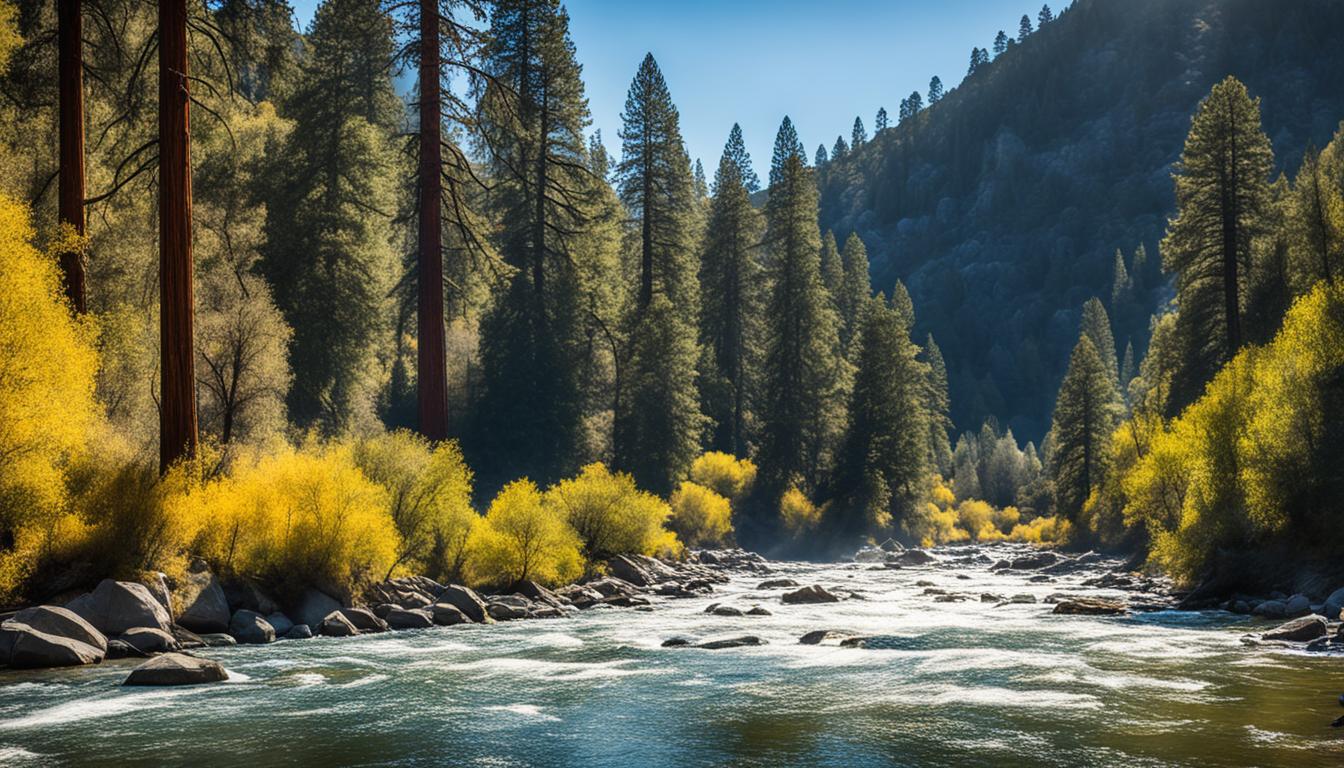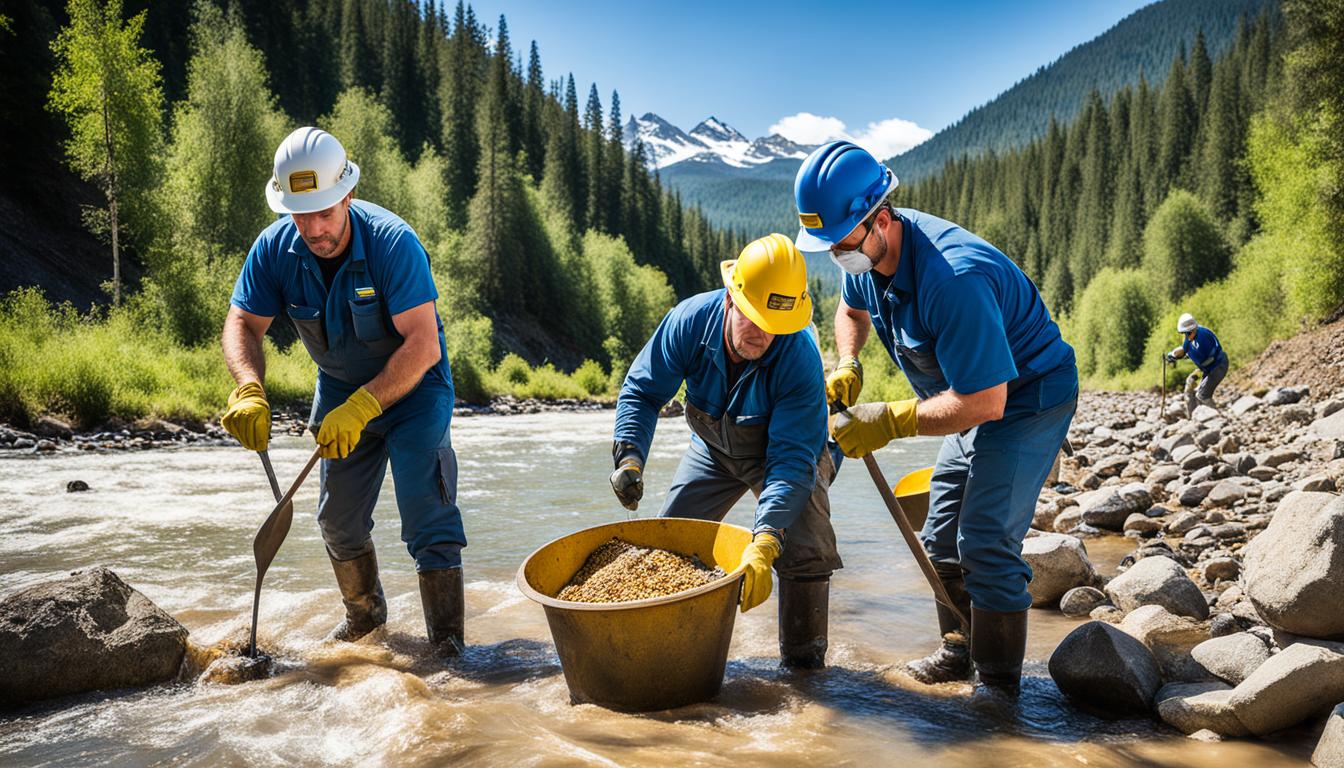The value of gold has been going up, sparking more interest in gold hunting across the USA. In 1852, the peak of the California Gold Rush saw $81 million in gold found. In today’s dollars, this value would be about $3.2 billion. Even 200 years later, people are still looking for gold in the West.
American public lands are popular spots for this search. The excitement of finding gold draws in history lovers and the adventurous. Those involved often speak of it as a unique and exciting adventure. With the rising price of gold, it’s a great time to try gold prospecting.
Introduction to Gold Prospecting
The California Gold Rush of 1848 changed the United States forever. It all started when a worker found gold dots in the water at Sutter’s Mill. This discovery sparked a massive movement of people, known as 49ers, heading to California to seek their fortune. The thrill of the hunt has drawn people who have been fascinated by history and adventure ever since.
Historical Significance of Gold Mining
By 1852, gold worth $81 million had been found in California, about $3.2 billion in today’s money. This influx of prospectors marked the beginning of a new era. People from all over the country came to find gold nuggets and make life-changing gold discoveries.
The Allure of Gold Panning
Imagine finding your first piece of gold, its excitement, and the bonds formed among prospectors. This is the essence of gold hunting. For many, gold panning is about more than riches; it’s about the joy of the process. Seeing that first flake of gold in your pan can be addictively thrilling. For some, uncovering the history of the places they search is as rewarding as finding the actual gold.
The California Gold Rush
The California Gold Rush has left an indelible mark on American history. A gold rush ensued thanks to a worker’s discovery at Sutter’s Mill. The atmosphere was electric as the 49ers hurried to California. The search for gold resulted in a staggering $81 million fine by 1852, hugely significant even today.
Nevada’s Desert Gold
Nevada mines almost 75% of the yearly U.S. gold using professional methods. Yet, it does allow non-professionals to look for gold on public lands. The Rye Patch State Recreation Area in Lovelock, just 90 miles from Reno, is a hot spot for this. In its mining heyday, the Rye Patch Mill found over $1 million in gold and silver. It’s now a ghost town but still draws gold hunters.
Rye Patch State Recreation Area
The Rye Patch State Recreation Area, just outside Lovelock, is a top spot for finding Nevada gold. This spot, near Reno, had the famous Rye Patch Mill. It pulled out over $1 million in gold and silver, then closed in 1877. Today, it’s a ghost town that draws people from all over. They come looking for hidden gold flakes and nuggets, some with a unique chevron pattern.
Dry Washing and Metal Detecting
Nevada’s dry and tough ground calls for particular ways to find gold. Dry washing is one method. It blows air over the soil to pick out the heavy gold from the rest, meaning people can hunt for gold without water. Metal detectors are also vital for Nevada gold prospecting. They help find buried gold deposits in Nevada’s arid countryside.
The American River in California
Gold panning along the 119-mile American River east of Sacramento is famous. It marks where the California Gold Rush started. About 49ers found over 750,000 pounds of gold in its waters. Although the gold rush is less active today, people still discover gold nuggets there.
Auburn State Recreation Area
People can pan for gold for free at the Auburn State Recreation Area. It’s situated on the border of Placer and El Dorado Counties. Only traditional gold pans are allowed, not other tools for hunting gold. Thanks to the melted snow from recent snowpacks, there’s a buzz that gold flakes could be easier to find now.
Hydraulic Mining and Sluicing
The Auburn State Recreation Area is rich in hiking trails and natural beauty. It is perfect for those who enjoy panning for gold and exploring. Hydraulic mining, which involves using water to find gold, was a big part of the California Gold Rush. Another popular method is sluicing, where a sluice box filters out the gold.

Alaska’s Yukon River
Since 1896, Alaska has attracted gold seekers. This was when gold was found in the Canadian Yukon, leading to the Klondike Gold Rush. Over 100,000 people moved to Alaska and the Yukon, looking for gold. The Dalton Highway is now a key area for those seeking this treasure. It runs for 414 miles from Livengood, Alaska, to Prudhoe Bay on the Arctic Ocean.
There are places along the highway known for good gold panning. The South Fork Koyukuk River is particularly famous. This area has been productive for amateurs because many commercial mining operations left due to transportation issues.
Dalton Highway and Koyukuk River
The Dalton Highway, running 414 miles from Livengood to Prudhoe Bay, is perfect for gold enthusiasts. Some parts along the way, like the South Fork Koyukuk River, are great for finding gold. Even though commercial mining has slowed here, amateur hunters still have a chance to strike gold.
Discovery Channel’s “Gold Rush” Series
The “Gold Rush” show on the Discovery Channel has been running since 2010. It highlights the adventure and success of miners in Alaska. This program has encouraged many to consider Alaska as a treasure-hunting destination, showing them what’s possible.
Where is Gold Most Commonly Found
The Cache Creek mine in Twin Lakes, Colorado, operated for over 50 years. It closed in 1911 due to an environmental case. Though the mine stopped, there was still gold there.
In 2000, the Bureau of Land Management (BLM) bought over 2,000 acres near Cache Creek to keep the space open and protect the elk’s home. Today, people can go and pan for gold there for fun. But they must follow rules, like using tools that won’t harm the land.
Recreational Mining Regulations
People are more interested in finding gold for fun. Because of this, some old mining spots are now open to the public. But they come with rules. Only specific tools can be used to protect the land. Also, there’s a small fee to enter.
Arizona’s Lynx Creek
Arizona mines copper, silver, and turquoise. Interestingly, it’s also the fifth-best place for finding gold in the U.S. Gold was first found in the Gila River in the mid-1800s, leading to booms and busts in several mining towns. South of Prescott, the Bradshaw Mountains have always been famous for their gold.
Bradshaw Mountains and Prescott National Forest
Prospectors can explore the Prescott National Forest all year. It has over 100,000 acres and 950 miles of trails, including Lynx Creek and Lynx Lake. These areas have previously seen gold finds, and the beautiful scenery gives gold seekers great chances to find hidden wealth.
Geological Indicators of Gold Deposits
Gold prospectors often seek out areas rich in certain minerals, which can show the presence of gold. Geologists play a key role by studying rock and soil samples to see what minerals are present and checking the chemical makeup of the rocks. Prospectors eye geological features like quartz veins and other specific minerals, which can be signs that there might be gold deposits nearby.
Quartz Veins and Mineral Formations
Quartz veins and unique mineral formations are crucial when finding gold. Prospectors scan the land for these clear geological signs, knowing that these indicators could lead them to areas where gold might be more abundant.
Consulting Geologists and Mining Maps
Gold hunters don’t just rely on their skills; they also work with geologists. Geologists can offer deep insights into the land’s mineral makeup and help point out the places with the most potential for gold. It’s also common to look at historical mining maps. These maps show where gold and other minerals were found before and hint at where new deposits might be found.
Prospecting Techniques and Methods
Gold prospectors use various methods to find and gather gold. They often start with the classic technique of gold panning. This involves using a pan to sort gold from other materials in waterways like rivers and streams. Sluicing is another method. It uses a special box to catch gold when water flows through it. Both gold panning and sluicing are well-loved methods in the field.
But there’s more to how they work. Metal detectors help find gold that’s hidden underground. Dry washing is also vital. It lets prospectors sift gold from sand and gravel in dry areas, using air instead of water. These tools are fundamental for all types of locations.
Responsible and Ethical Gold Prospecting
Interest in gold prospecting is rising, making it crucial to do it right. Prospectors need to follow regulations and guidelines which protect nature and its habitats. They should also use non-motorized tools and pay entrance fees, which help minimize the impact of their search.
Environmental Considerations
Being a responsible gold prospector means caring for nature. Prospectors must protect the places they mine, follow regulations, and use responsible mining help. Prospectors can ensure their gold search does not hurt the environment, keeping natural resources and habitats safe.
Obtaining Permits and Respecting Claims
It’s not just about the environment. Prospectors must know the law, too. They need to get prospecting permits. And they should respect others’ staked claims. This is key to an ethical and responsible gold hunt. Following these rules ensures a well-done job.

Conclusion
Gold prospecting remains widespread across the United States. Prospectors are excited about the hunt and the chance to find gold. Locations from the American River in California to Alaska, Nevada, and Arizona offer opportunities to find gold.
The California Gold Rush may be over, but the thrill of finding gold stays strong. Modern prospectors use many methods to find this precious metal.
Interest in gold prospecting is increasing. Prospectors must act responsibly, follow the rules, and be mindful of others’ claims. This will help keep the tradition of gold prospecting alive and ensure the environment is protected for future explorers.
Gold hunting has changed, but the adventure and excitement are still here. Prospectors aim to find treasures while protecting the earth and respecting others’ rights. This way, gold mining and prospecting magic can last for future generations.




